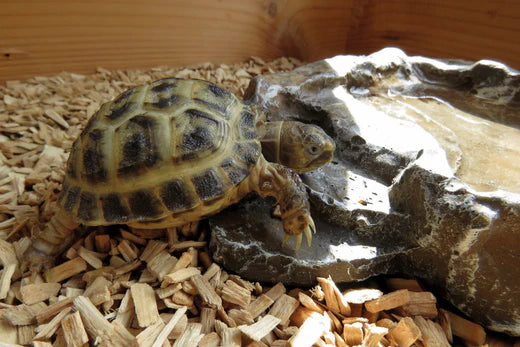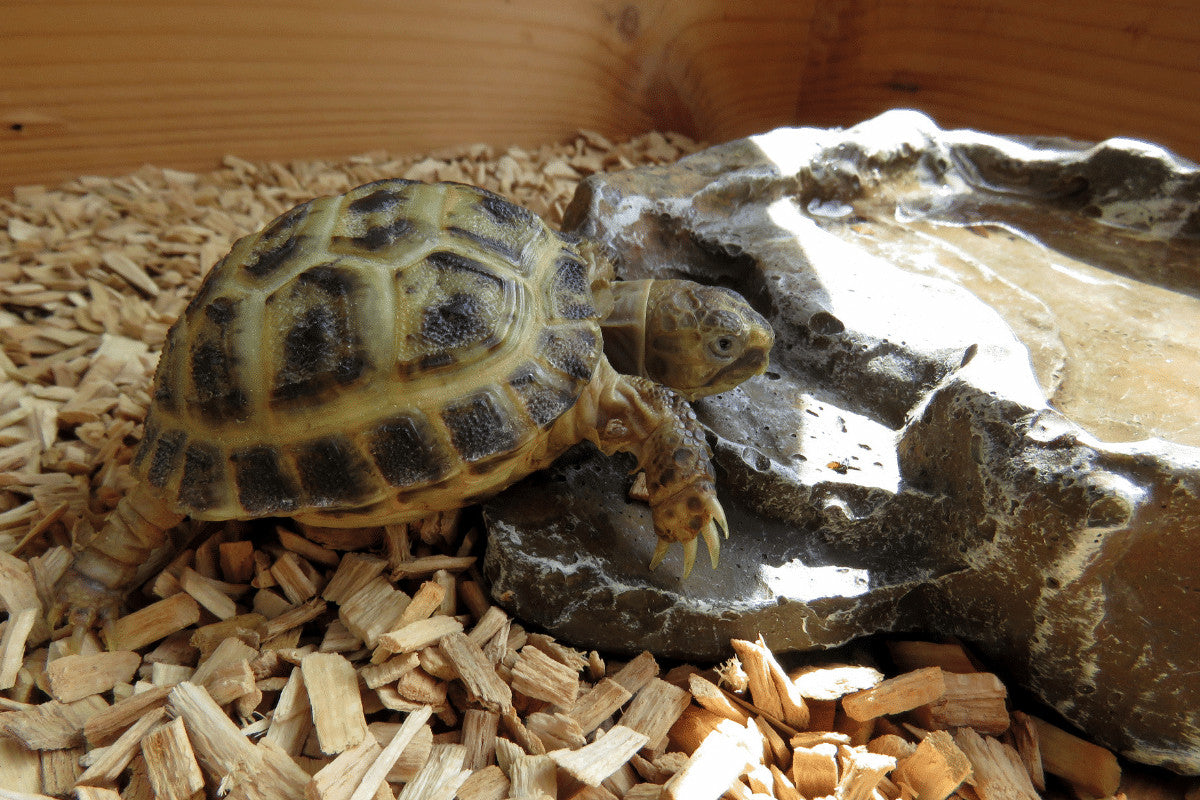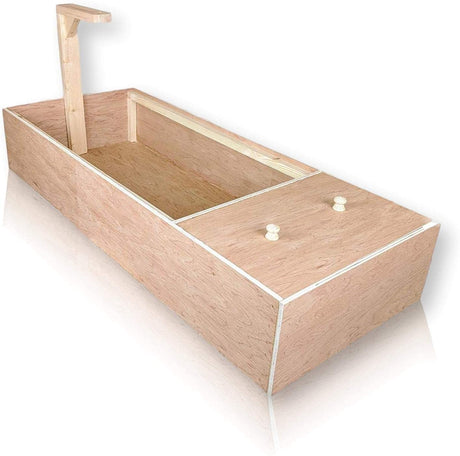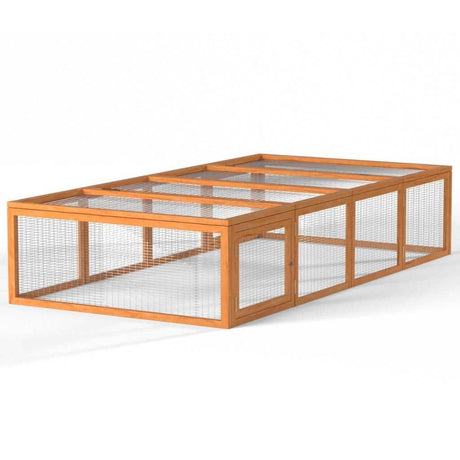Types of Tortoise House
There are several types of housing that you can choose for your tortoise and they all have different requirements, costs, and benefits.
Vivarium
A vivarium is an enclosed space with a glass front; you will likely have seen snakes and lizards in vivariums. Due to the sliding glass front, it can be difficult to clean and maintain the interior or to check on your tortoise throughout the day. They are more commonly found in smaller sizes but are great for creating a warm and humid environment, perfect for tropical tortoises.
Outdoor Enclosure
Many people opt to keep their tortoises in an outdoor habitat which is especially popular in the larger species, for obvious reasons. You must take extra precuations against pests and predators if your tortoise is spending a lot of time outside. Living outdoors allows your torotise to regulate more naturally however this is not recommended for juvenile tortoises or hatchlings.
Tortoise Table
Tortoise tables are open-top enclosures that allow you to have easy access to the entire space. There is often a small covered area that you can lift up for cleaning and maintenance. Most are made from wood and come in a range of larger sizes to suit your tortoise's needs.
Some starter tortoise tables come with everything you need to get started however if this isn't an option, we are going to cover all you need to know about creating a stimulating environment for your special animal friend.

Size
The size of your tortoise enclosure depends on the size of your tortoise. You need to make sure that the sides of your tortoise table are tall enough that they cannot climb up and out; while small tortoises such as Russian tortoises will be perfectly safe in something with a height of 20cm, other tortoise species may need something taller.
Another good way of ensuring you provide enough space for your tortoise is by looking at it in proportion with your tortoise's size. The length of your tortoise table should be around 10 times the length of your tortoise, and it should be around five times as wide as the width of your tortoise.
With this in mind, we recommend buying a larger option so that you don't have to replace it as your tortoise gets older and continues to grow.

Lighting
Tortoises require forms of UV light to be able to perform various bodily functions. UVB light enables them to synthesis Vitamin D3 which in turn is used to metabolise calcium. Calcium is an important nutrient required for your tortoise's growth and development, as well as to strengthen your tortoise's shell.
Without sunlight or an artificial alternative, tortoises will suffer from many health issues that are often irreversible or sometimes even fatal. This is especially important in a juvenile tortoise or hatchlings however UVB light should be provided throughout a tortoise's entire lifetime.
Although your tortoise table may be set up next to a bright window and it may seem like there is lots of natural sunlight coming through, this is not sufficient lighting for your tortoise's needs. UVB rays are greatly reduced when passing through glass, plastic, and even a fine mesh, therefore your tortoise will not receive their required amount unless it is completely unfiltered.
How Far Away Should the UV Lamp Be?
It will depend on what kind of UV lamp you get, however, a general rule is that it should never be placed more than 46cm away from where your tortoise will be basking, but desert tortoises such as the Indian star tortoise can require them to be as close as 25cm for them to be able to get sufficient amounts of UVB rays.
UV bulbs are classified based on their amount of UVB output which can range from as little as 3%. This amount is often sufficient for most tortoises as long as you place them close enough and replace them frequently. The individual lamps will have guidelines with them to ensure you are using them correctly and, most importantly, safely.
Most UV bulb manufacturers recommend replacing them every 10-12 months to ensure the best performance for the needs of your beloved pets.
Timers
8-10 hours of light is usually sufficient for the needs of your tortoise, however, this can vary depending on whether you have a tropical species or desert species, in order to replicate their natural environment.
To maintain their natural daily cycles, their lights should be turned off at the end of each day. To ensure that this happens, many people opt to buy timers that will automatically turn the lights on and off again whether you remember to do so or not.
Heating
Tortoises, as with other reptiles, are cold-blooded therefore need sufficient heat to be able to complete their natural bodily functions such as digesting their food and even moving from one place to another. You can get lamps that will provide both heat output as well as the required UV light, however, these can be purchased individually, too.
As long as your heat lamp does not emit any light, such as a red basking bulb, you can generally use it 24 hours a day. However, this may only be necessary if the room gets cold at night.
It is important to create a heat gradient so that your tortoise can move away to cooler areas of the tortoise table if it needs to therefore you shouldn't place any additional heating in other parts of your tortoise table.
A heat mat may a good option to keep your tortoise cosy however if your tortoise table has an adequate temperature gradient, then they are not always necessary.
Thermometer
If a heat lamp or basking bulb is placed too close to your tortoise's shell, it can cause burns or dehydration. As we mentioned before, creating a heat gradient is important to allow your tortoise to move away if it gets too hot.
This is why thermometers are important aspects to have in your tortoise table set up. We recommend buying two high-quality thermometers so that you can monitor the highest temperature under the basking lamp, and the lowest temperature on the opposite end of your tortoise table.
It's also important to measure the temperature directly underneath the basking lamp at the same height as the top of your tortoise's shell; this is where the tortoise will be the hottest and therefore it is important to make sure that this doesn't exceed 35C.
You can also buy thermostats that will control the heat lamps and automatically turn them off when your indoor tortoise enclosure reaches a certain temperature.
Substrate
There are several substrates that can be great for tortoise tables. Whatever you choose to line your tortoise table with, it should remain dry and spot cleaned regularly; this can be done easily using a scooper tool.
- Bark or mulch can be used and is a highly popular option that also smells quite nice for us humans, too
- Alfafa or hay is an edible option that your tortoise can snack on throughout the day. You may need to change this substrate more frequently which, as a more expensive option, may not be cost-effective
- Soil is a great natural option as long as you find an organic, chemical-free variety that is safe for tortoises however this will leave your tortoise a little muddy
For young tortoises, the depth of the substrate should be around 2 inches however older tortoises may prefer this to be a little deeper so they can dig and burrow.
You shouldn't need to replace the substrate very frequently; every few months is usually sufficient depending on how many pet tortoises you have and what you feed them. You may need to replace any substrate that gets damp near their water bowl to prevent any bacteria from growing.

Liner
Although a liner is not necessary, it will preserve the wood of your tortoise table and make it easier to remove the substrate when it's time for that deep clean.
You can buy a special plastic liner or simply use a heavy-duty bin bag; fit it in the bottom of your table and cover it with the substrate of your choice. Make sure none is sticking out the sides as your tortoise may be tempted to nibble on it.
Hiding Places
Just like our other pets, tortoises have different personalities and some may be shyer than others. Either way, you should always provide areas that your tortoise can hide away from the outside world if they need to. There should also be areas that are cooler than others if it should get too hot.
Some tortoise tables will feature a covered area on one end where your tortoise can retreat to, however you can also buy little log hides and special houses for them to hide away in. You may notice your tortoise using these areas if they are scared, so don't bother them too much if they decide to hide away sometimes.
Food and Water
Arguably one of the most important aspects of your tortoise's enclosure is designated areas for their food and water. Your tortoise should have access to clean drinking water throughout the day in a shallow but sturdy bowl. Many tortoises love to sit and soak in their water bowl so be prepared to clean this regularly, as they sometimes even defecate in it, too. The water bowl must be easy for your tortoise to climb in and out of, with no risk of them getting stuck.
Your tortoise's food should be placed away from the heat source to avoid it going bad. It can also be a good idea to put the bowl on a tile or a piece of slate so if your tortoise pulls some food out, they won't drag it straight into their substrate and risk ingesting something they shouldn't.

Plants and Furnishings
Indoor enclosures can be just as green as their outdoor counterparts, so consider adding a few plants to break up the space a bit.
There are lots of great options for plants that you can put in your indoor enclosure however it's important to choose ones that are not toxic for your tortoise so research any plants before you place it in your tortoise enclosure:
- Aloe vera is safe for your tortoise however can have laxative effects if eaten too much
- Clover can be as big or as small as you like and it's easy to maintain, what's more, it's safe for your tortoises to eat as part of a balanced diet
- Dandelions can be taken from your garden and added to your tortoise enclosure but they may not last long as these are a favourite food of many species
- Pansies are a colourful addition to your tortoise, don't take up too much space, and are a safe snack for your pet tortoise to enjoy
These are just a few favourites that are easy to source and are healthy for your tortoise to eat as part of their diet. As with everything, be careful to monitor how much they are eating and remove it if you think it is having any negative effects. We recommend leaving them in pots a little above the surface of the substrate so they can easily be removed and maintained if needed.
If you choose to buy plants from a supplier, be sure to check that they are not grown with chemicals that could be harmful to your tortoise, this includes the soil that is used to grow them, too. Place your plants away from the heat bulb as they can burn if put directly under a lamp.
Be careful not to place anything underneath the heat source where your tortoise could flip over and get stuck; if they were to be stuck underneath the lamp for long periods of time it could cause them serious harm.

Humidity
The main downfall of tortoise tables is that it can be difficult to maintain their humidity, unlike vivariums which are often much hotter and more humid. Some tropical tortoises such as the red-footed species require more humidity than others; if you own a Hermann's tortoise, they require their environment to be a lot drier therefore check your tortoise's specific requirements to ensure you get it right.
In the winter, when you have the central heating on, it can get very dry in your house which can cause your young tortoise to develop a misformed shell. To keep the humidity up, spray the enclosure with water on a regular basis or consider adding some tortoise friendly moss to their space, too.
Be sure not to spray any of the lamps or electrics you may have in your tortoise enclosure as it could cause them to short circuit.
Where Should I Put My Tortoise Table?
One of the first things that you should consider is placing your tortoise table near a plug socket so that you can easily power your UV light and heat source.
Try not to place tortoise tables near a radiator or any draughts that could drastically affect the temperature and humidity of your tortoise table.
Whether you keep your tortoise indoors all the time or not, you should keep them away from busy areas of your home and away from children or other pets. Keeping your tortoise in a high traffic environment can cause them unnecessary stress, and a stressed tortoise can suffer from various health issues that can even be fatal.
Can I Let My Tortoise Outside?
Definitely! If you don't keep your tortoise outdoors on a permanent basis, then you can easily create an outdoor space for them to enjoy on warm days. You can use chicken wire to make a safe perimeter, remove any toxic plants, and add some shelter for them to get out of the sun if they need to.
We don't recommend letting your tortoise roam freely around the garden unsupervised however there are many ways they can enjoy the outdoors in a safe and controlled way so they can get their daily dose of direct sunlight and explore a new environment.
Maintenance
Tortoises tables are a great way to keep your tortoise indoors in a stimulating environment, however, it is important to maintain it properly to ensure the best welfare for your beloved pet turtle.
- Regularly check your bulbs and heat lamps to ensure they are functioning correctly, and check the temperature several times a week to ensure it remains consistent and doesn't get too hot or too cold.
- Spot clean daily to clean out any faeces, wet patches, or old food, and then replace the substrate completely every few months.
- Be sure not to place anything too close to the edges of your tortoise table as many species of tortoise, such as the Horsfield tortoise, are great climbers as they are naturally found in rocky environments. They can use these items to climb up and out of their enclosure which can be dangerous, especially if they fall from a great height.
- You should also maintain plants on a regular basis to ensure they do not become overgrown and check how much your tortoise snacks on them, too.
- Provide fresh water on a daily basis and clean the water bowl at least once a week.
Alternative Housing
If you cannot find a tortoise table, guinea pig hutches or even a large plastic container also make safe alternatives, albeit maybe a little more temporary. As long as you can attach the lamp to the inside of the enclosure, it is large enough for them to move around and find cooler spaces and has all of the requirements we have previously mentioned, there is no reason you can't opt for something other than a tortoise table.
Setting Up Your Tortoise Table
Your tortoise’s environment should not only be a safe place to be but it should be stimulating for them too; although water bowls and heat lamps are vital, you shouldn’t hold back from putting extra plants, rocks, and logs for them to interact with, too. Remember to keep your tortoise table away from loud noises and curious pets, and always check the temperature range to keep your shelled friend happy and healthy.
Now you know how to set up a tortoise house there is no reason your beloved pet should get anything less than the best. From heat sources to substrate type, there’s a lot of information to absorb but we hope that we have answered all of your questions and you are confident that you can provide a great enclosure for your tortoise to grow in.
Let us know about your tortoise setup in the comments.





1 comment
Hi. I have read up the information you have provided on tortoises on here, very informative, thank you.
I wonder if you can help with my situation please?
A family member has found a tortoise over two weeks ago, they have advertised it on lost and found sites etc and nobody has claim it
I have volunteered to re home it ☺️
They think it’s a Russian tortoise. Could you tell me How do I find what sex it is and the rough age of it?
Also my main concern is whether its been kept indoors or outdoors, during its life. What do you suggest I home it in and indoors or outdoors?
Any advice would be greatly appreciated
I’m collecting it tomorrow and can do a make shift house for it, but as I said my main concern is whether it’s indoors or outdoors?
Thanking you in advance
Laura x